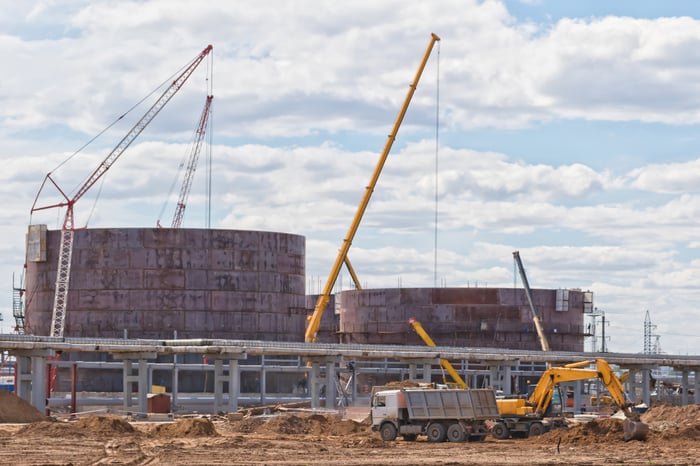TransCanada (TRP -0.33%) seemed to stumble backward in the third quarter, considering that cash flow plunged more than 29% on a per-share basis versus the year-ago period. At first glance, that steep decline makes it appear as if the company's generous 3.7%-yielding dividend might not be on solid ground. However, that's not the case.
That was clear from the comments of the company's management team on the accompanying third-quarter call, where they pointed out that the dividend was not just safe, but headed meaningfully higher over the next few years. Here are three points they made on that call to back up this view.

Image source: Getty Images.
Some tough comps masked a fine quarter
CEO Russ Girling noted that the company's results were lower than they were in the third quarter of 2016. He went on to explain:
The declines were largely attributable to the impact of issuing 60 million common shares in the fourth quarter of 2016 and the sale of our U.S. northeast power generation assets in the second quarter of 2017. Effectively, in the third quarter 2016 we enjoyed the benefit of having both the Columbia and U.S. northeast power assets in our portfolio funded by a low cost bridge facility pending the subsequent permanent financing of the Columbia acquisition in the form of the November 2016 equity issue and the second quarter 2017 power generation assets sales.
Girling pointed out that the company went up against a real tough comparable quarter where results were artificially higher because it benefited from the acquisition of Columbia without fully paying for that deal, since it had a temporary loan in place. However, it has since sold stock and some assets to pay off that loan, which is why earnings seemed to plunge last quarter. Girling would go on to note that cash flow is up 12% per share so far this year, so the company's financial results are heading in the right direction.
We made good progress with our building program
While the Columbia deal fueled much of TransCanada's growth in the last year, organic expansion will be the story going forward. Given the importance of its growth projects, Girling provided the following update:
We continue to advance a $24 billion [Canadian] ($18.8 billion) program largely on time and on budget. In total we invested approximately CA$2.5 billion ($2 billion) during the third quarter. This includes amounts related to the expansion of NGTL and Columbia, as well as the Mexican natural gas pipeline projects, regional liquids projects in Alberta and then Napanee and Bruce Power projects bringing the cumulative investment in this CA$24 billion program to approximately CA$10.4 billion ($8.2 billion).
Overall, the company made excellent progress on its expansion program this year, investing several billion dollars across many projects. As they enter service, they'll provide the company with a growing stream of cash flow to support future dividend increases, since long-term, fee-based contracts underpin each project.

Image source: Getty Images.
We also made good progress securing the financing we need
That said, the one thing that could derail dividend growth, even if the company completes all those projects, is access to funding. Girling noted that the company still needs to spend about CA$13.5 billion ($10.6 billion) through the end of 2019 to finish its current slate of projects.
That leaves TransCanada with a significant gap to fill, since excess cash, after paying the dividend, will only cover about half that amount. However, CFO Donald Marchand noted on the call that the company continues to steadily raise the funds it needs.
First, he said that it currently has CA$1.4 billion ($1.1 billion) in cash on hand, thanks in part to a CA$1 billion ($790 million) debt offering in September. In addition to that, it will receive about $1.1 billion ($860 million) in the next few months from a cost recovery on a canceled growth project and the sale of its solar assets in Ontario.
Meanwhile, he noted that the company has "multiple financing levers available" to obtain more money, including issuing preferred shares and hybrid securities, completing additional asset dropdowns to its MLP TC Pipelines (TCP), and using its strong credit rating to raise more debt. The company has already used several of these levers in the past year, including dropping down $765 million in assets to TC Pipelines. That led him to conclude that, "while our external funding needs are sizable, they are eminently achievable."
Heading toward the high end
Because of that, TransCanada should have no problem continuing to pay a growing dividend. In fact, Girling stated on the call that he believes the company can continue "growing the dividend at the upper end [of the] 8% to 10% range through 2020." That's great news for income investors because they can collect an excellent income stream right now that appears poised to grow at a healthy rate over the next few years.





